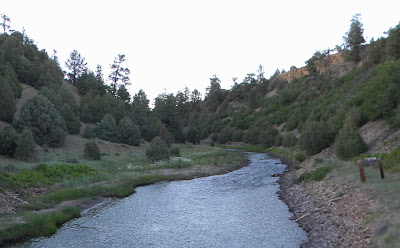Willow Creek and Water for Heron Lake
 Looking upstream at Willow Creek from the Laguna Vista bridge while the creek is flowing at about 100 cubic feet per second. About a mile downstream of this point is the beginning of Heron Lake, and another mile downstream is Willow Creek Cove and the Heron Lake Marina, owned and operated by the New Mexico Sailing Club.
Looking upstream at Willow Creek from the Laguna Vista bridge while the creek is flowing at about 100 cubic feet per second. About a mile downstream of this point is the beginning of Heron Lake, and another mile downstream is Willow Creek Cove and the Heron Lake Marina, owned and operated by the New Mexico Sailing Club. Downstream view of Willow Creek; after bending to the right away from the cliff in the background, Willow Creek makes some more bends and meanders as it flows into the Willow Creek or upper arm of Heron Lake and then through a narrow passage to Willow Creek Cove and the main Narrows.
Downstream view of Willow Creek; after bending to the right away from the cliff in the background, Willow Creek makes some more bends and meanders as it flows into the Willow Creek or upper arm of Heron Lake and then through a narrow passage to Willow Creek Cove and the main Narrows. Through a complicated series of treaties, regulations, and water compacts, various entities agreed to provide New Mexico's Rio Grande basin communities with water diverted from the western slope of the continental divide.
Through a complicated series of treaties, regulations, and water compacts, various entities agreed to provide New Mexico's Rio Grande basin communities with water diverted from the western slope of the continental divide. In a theoretically normal year, the so-called sustainable yield of 96,200 acre-feet of water would be diverted through a series of tunnels into Willow Creek, which lies to the west and south of Chama, New Mexico.
A minimum stream flow must be kept in the streams that are being diverted and in dry years little or no water may be diverted through the Azotea Tunnel into Willow Creek and then Heron Lake. The water contractors are still entitled to the 96,200 acre feet of water if it can be delivered, so in a dry year the lake can go down. In wet years, more water than the sustainable yield can come into Heron Lake and the excess can be retained. The maximum amount of water that can come into Heron Lake is restricted by the capacity of the tunnels, the duration of the snowmelt season, and certain limits within the Compact that established the San Juan-Chama Project.


0 Comments:
Post a Comment
<< Home